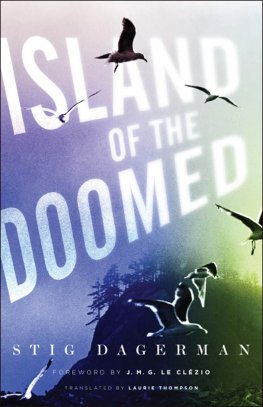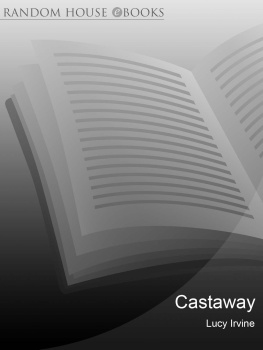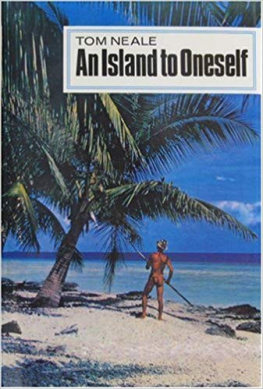Stig Dagerman
Island of the Doomed
FOREWORD: THE STAR OF MYSELF BYJ. M. G. LE CLZIO
Here is undoubtedly one of the strangest novels of the twentieth century, written in haste and with passion, and which irresistibly evokes another book (not a novel, but where to draw the line?) published in the middle of the preceding century by a young man (of the same age, in fact) under the title Les Chants de Maldoror. In reality, very different books, one produced by the unbearable exile of a young Uruguayan in the most typically intellectual city of his time, the other by a militant in the anarchist movement that culminates in the rise of fascism and war. Yet, what one reads in these books is similar, even if Dagerman never mentions the writing of Isidore Ducasse: one finds in them the same resurgence, the same iconoclastic and torrential, uncontrolled, darkly jubilant will, the same self-destructive humor. What links these two books is the period, the extreme conformism of the bourgeoisie of the Second Empire for Ducasse, for Stig Dagerman the loathing of the right-thinking politically involved people, the self-satisfied militance during clashes between classes, and the birth of great humanitarian undertakings all of which was negated by the cowardice of abandon in the Spanish civil war and by the obscenity of the dictatorships in the Soviet Union and Latin America. Another literary example of the spirit of the times would be the pessimistic and suicidal Juan Rulfo, author of one of the key novels of the twentieth century, Pedro Pramo, conceived in the violence of the counterrevolution in Mexico in the 1930s.
But is Stig Dagerman only the product of an era? Island of the Doomed is his second novel, following closely on the heels of the literary success of The Snake, and it places him on the path of intellectual and moral solitude. It is as will be all his novels a text loaded with his own experiences, his rebellions, his failures, but (more than any of the others) consisting of curses and despair, articulating his rejection of all humanistic comfort. A purely anarchist novel? No doubt, since it denies all progress achieved through violence and shuts itself up in the closed universe of a small island, at once stalag, military camp, penal colony, and insane asylum. A piece lost in the imaginary republic of Velamesia, where there are no laws, no money, no armed police in short, an anarchist paradise, except that you kow-tow with the same unwilling willingness, let yourself be subjugated, feel this fatal sensation of impotent inferiority.
Like the exile of Montevideo, Stig Dagerman is led to a rediscovery of all the elements that have obsessed his life the crushing image of the father, Cronos, who tortures and devours his children, and the tyranny of the Boss, wielding an absurd and flexible authority in his reign over a servile population locked into a nightmarish dcor on this island surrounded by a poisonous lagoon where supreme punishment prowls a great invisible exterminating fish. The only heroes on this island are the romantic Lucas Egmont from another century; Loel (who reminds of Falmer in Les Chants de Maldoror), angelic, devoted to sacrifice; the giant Tim Solider; or the lost aviator Boy Larus, who finds consolation only next to an erratic young Englishwoman. The hero is all those at the same time, obsessed by an invisible wound that eats at his body, like the fox in the Spartan fable. Stig Dagermans imaginary is close to the Surrealists, except (and here again he reminds of Lautramont) that chaos emerges from within the narrator, and no longer in his gaze on the external world. We are far removed from the absurd: on the contrary, for Egmont, war, organized crime, and treason are consequences of the unconsciousness of victims. Living meant obeying and obeying meant never wanting anything, obeying meant receiving and passing on whatever couldnt be kept and letting whatever couldnt be passed on stay and form new wounds.
Dead end. As is usually said, on an island there are no thieves, because where would they hide? In the end, the captain is condemned to death, and the hero to live as a living dead person in his dream world where pure cruelty (the free lions, the sawfish of the depths) triumphs.
What we find astonishing and upsetting in Stig Dagermans novel is the perfection of the destiny he portrays in the absolute ardor and sarcasm of youth, this destiny that is so short-lived. This tumultuous novel, a whirlwind of sensations and images, in a way contains Dagermans entire oeuvre his novels, his poems, his political essays. He holds them not like a matrix but rather like a fatal vortex in which everything is slowly carried along and broken down. For that reason, reading a book like Island of the Doomed does not leave us undamaged, and makes us question today our illusory certitudes. On the one hand, as the captain says, the boundless solitude of the world, its greater than anyone dares to imagine apart from a few ecstatic moments when theres nothing you can do about them, but even so, you can feel it in every nerve-end. And, on the other hand, like the trick stone hidden in the hand of the bettor Lucas Egmont, this superior force of existence (without which there is no existence), lucidity: the open eyes which fearlessly scrutinize their dangerous position must be the stars of our ego, our only compass, the compass which decides which direction we take, because if there is no compass, there can be no direction.
In humble recognition to Stig Dagerman, who burned himself up to show us the way.
April 2010
Translated by David Thorstad
Two things fill me with horror: the Executioner
within me and the axe over my head.
Mind you, gin with a touch of meltwater from a cascading mountain stream, a few half-chewed young holly leaves, a pinch of roasted cardamom soaked in gallic acid, hastily swallowed at dawn as the car door slams shut on the last peal of laughter ah, well -
Lucas Egmonts right hand crept a little way in his sleep over the rough, glittering, salt-encrusted sand, dragged by his finger tips. Was it caressing a cheek? A long worm, white, but with thread-like, closely-packed joint rings in deepest black, suddenly seemed to emerge from the lapping surf and come wriggling over the gently sloping beach, menacing, terrifying. Was it real, or was it just a figment of his fear?
Lucas Egmont lay prostrate with his uninjured leg pressed close to the ground, a position not as comforting as it seemed, since quite soon after sunset the sand began to transmit a sharp, aggressive chill which enveloped his limbs in an inflexible film, hard as armour-plate, becoming ever more unyielding as this island fell further and further through the night.
Yes, fell. Was he alone in noticing that the nights no longer wafted down from some roof up above, or that daylight no longer surged in like white gas filling the black balloon? No, the shifts were violent and unexpected: candles lit to produce an apparently reliable flame, and then suddenly snuffed out but the hand doing the snuffing was never glimpsed. Was he alone on this hurtling planet, this sand-strewn marble plunging down into the cosmic well? Transparent strata of air green at the edges, mauve streaks, deep-red flames flashing past and driving wedges like elephant tusks into ones own trembling being, which itself was constantly changing colour, chameleon-like, in the constant flux. Blue bands broken brutally asunder by exploding formations of violently yellow swallows wings. Fathomless darkness, the same air, but the colour itself must have a consistency enabling it to check the speed of descent. The fall through the night was no less terrifying, but now the pace was slower. Swarms of sparks rose slowly in the form of stars encircling the island and were visible far below in a grey, milky layer where white rivulets trickled in as if from some hidden giant udder.











